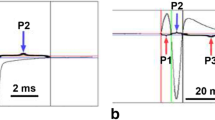Abstract
In this paper we attack the problem of understanding the localization of the main structures involved in the motor circadian rhythm of crayfish by analysing its ontogeny. We present experimental results giving the properties of this rhythm in young and adult crayfish. Then we construct a mathematical model (based on a previous one for the electroretinogram circadian rhythm in the same species) simulating those properties. In the process of constructing the model we clarified and made precise various hypotheses about the biological structures involved in them and about the characteristics of the oscillators present in those structures. We also formulate some hypotheses about the general properties of circadian rhythms. Finally, we propose some experiments suggested by the mathematical model.
Similar content being viewed by others
References
Aschoff, J. (1960). Exogenous and endogenous components in circadian rhythms. Cold Spring Harb. Symp. Quant. Biol. 25, 11–28.
Braun, M. (1983). Differential Equations and their Applications, New York: Springer-Verlag.
Chaple, W. D. (1948). Light and the movement of crayfish, Master thesis, Syracuse University.
Enright, J. T. (1965). The search for rhythmicity in biological time-series. J. Theor. Biol. 8, 426–468.
Fuentes-Pardo, B. and V. Inclán-Rubio (1981). Correlation between motor and electroretinographic circadian rhythms in the crayfish Procambarus bouvieri (Ortmann). Comp. Biochem. Physiol. 68, 177–185.
Fuentes-Pardo, B. and V. Inclán-Rubio (1987). Caudal photoreceptors synchronize the circadian rhythms in crayfish. I. Synchronization of ERG and locomotor circadian rhythms. Comp. Biochem. Physiol. 86A, 523–527.
Fuentes-Pardo, B., M. Lara-Aparicio and S. López de Medrano (1995). Perturbation of a circadian rhythm by single and periodic signals and its mathematical simulation. Bull. Math. Biol. 57, 175–189.
Fuentes-Pardo, B., M. Lara-Aparicio, S. López de Medrano and J. A. Viccon-Pale (1997). Motor circadian rhythm in crayfish. An experimental and theoretical study. Trends Comp. Biochem. Physiol. 2, 113–127.
Gordon, W. H., J. L. Larimer and T. L. Page (1977). Circumesophageal interneurons required for reflecive and circadian locomotor behavior in crayfish. J. Comp. Physiol. 116, 227–238.
Kalmus, H. (1938). Das Aktogram das Flusskrebs und seine Beeinflussung durch Organextrakte. Z. Vergl. Physiol. 25, 798–802.
Kalmus, H. and L. A. Wiggleswort (1960). Shock excited systems as models for biological rhythms. Cold Spring Harb. Symp. Quant. Biol. 25, 211–216.
Lara-Aparicio, M., S. López de Medrano, B. Fuentes-Pardo and E. Moreno-Sáenz (1993). A qualitative mathematical model of the ontogeny of a circadian rhythm in crayfish. Bull. Math. Biol. 55, 97–110.
López de Medrano, S., M. Lara-Aparicio and B. Fuentes-Pardo (1996). A qualitative mathematical model with two coupled non-linear oscillators simulating the behaviour of a circadian system. Appl. Math. Mec. ICIAM 95. 76, 311–312.
Page, T. L. and J. L. Larimer (1972). Entrainment of the circadian locomotor activity rhythm in crayfish. J. Comp. Physiol. 78, 107–120.
Page, T. L. and J. L. Larimer (1976). Extraretinal photoreception in entrainment of crustacean rhythms. Photochem. Photobiol. 23, 245–251.
Peterson, E. L. (1980). A limit cycle interpretation of a mosquito circadian oscillator. J. Theor. Biol. 84, 281–310.
Roberts, T. W. (1944). Light, eyestalk chemical and certain other factors as regulators of the community activity for the crayfish, Cambarus virilis Hagen. Ecol. Monogr. 14, 361–385.
Schalleck, W. (1942). Some mechanics controlling locomotor activity in the crayfish. J. Exp. Zool. 91, 155–166.
Viccon-Pale, J. A. and B. Fuentes-Pardo (1994). Synchronization by light of the circadian rhythm of motor activity in the crayfish. Biol. Rhythm Res. 25, 267–276.
Viccon-Pale, J. A., P. Ortega and B. Fuentes-Pardo (1997). Effects of illumination on the circadian motor rhythm of the chelipeds of crayfish. Biol. Rhythm Res. 28, 230–243.
Welsh, J. H. (1930). The mechanics of migration of the distal pigment cells in the eyes of Paleomonetes. J. Exp. Zool. 56, 459–494.
Welsh, J. H. (1938). Diurnal rhythms. Quart. Rev. Biol. 13, 123–139.
Welsh, J. H. (1941). The sinus glands and twenty-four hour cycles of retinal pigment migration in the crayfish. J. Exp. Zool. 86, 35–49.
Wever, R. (1965). A mathematical model for circadian rhythms, in Circadian Clocks, J. Aschoff (Ed.), Amsterdam: North Holland, pp. 47–63.
Author information
Authors and Affiliations
Corresponding author
Rights and permissions
About this article
Cite this article
Fuentes-Pardo, B., Lara-Aparicio, M. & López de Medrano, S. On the ontogeny of the motor circadian rhythm in crayfish. Bull. Math. Biol. 63, 353–369 (2001). https://doi.org/10.1006/bulm.2001.0227
Received:
Accepted:
Issue Date:
DOI: https://doi.org/10.1006/bulm.2001.0227




